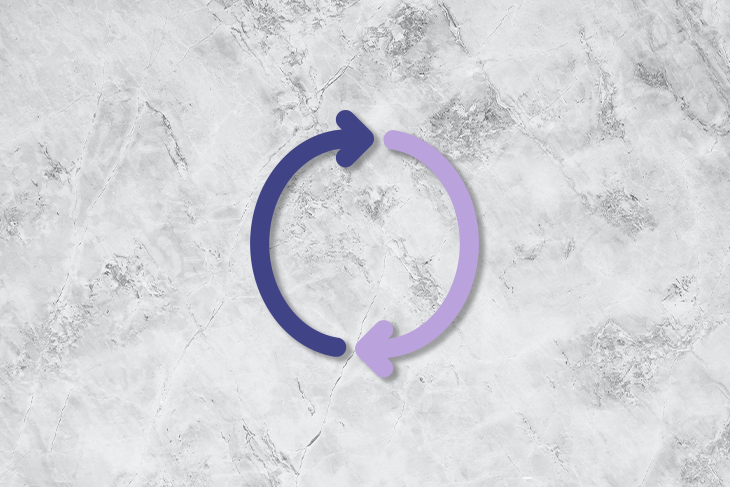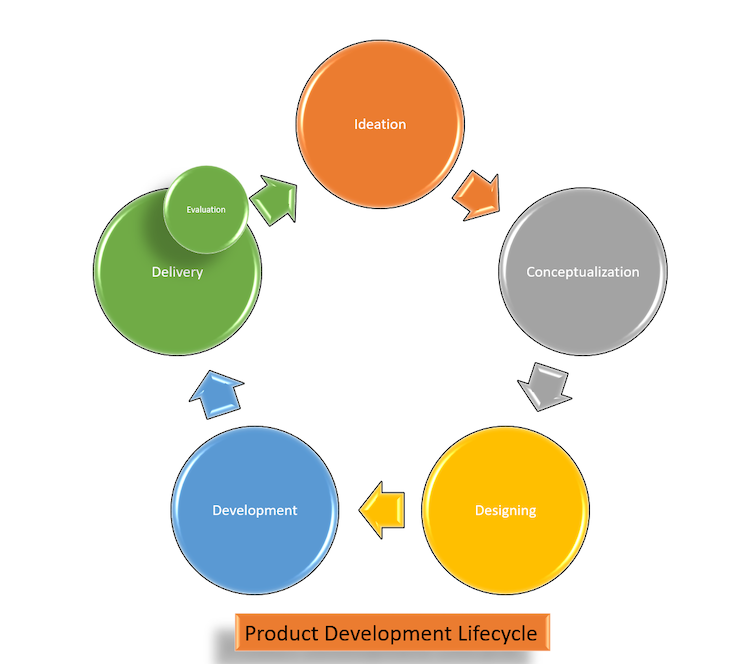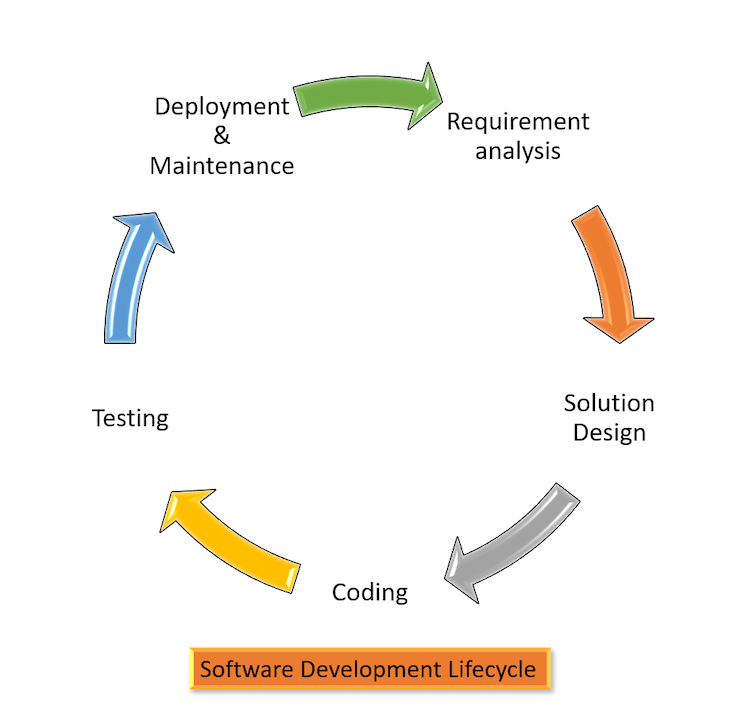Product development frameworks enable product teams to respond to changes in the ever-evolving market and solve customers’ needs quickly. The product development lifecycle defines the stages the team must undergo to deliver a valuable product to end users before it becomes obsolete.

The product development lifecycle (PDLC) is a subset of product lifecycle management that focuses on building and delivering during each phase.
The product development lifecycle goes through five stages. Depending on the size and scale of the organization and the product, these five stages can be broken down into the following steps.

Let’s explore each step in the PDLC in more detail and examine the product manager’s role throughout the process.
Ideation is the fun part for most product managers. Ideas can pop up at any time, any place. Even so, most are forgotten or never see the light of the day.
In product management, ideation is a proper step that is included in all frameworks. There are many proven ways to extract great ideas and concepts, such as brainstorming, mind mapping, hackathons, etc.
The product manager is not expected to devise the next big idea alone. Instead, they should facilitate the discussions and encourage the subject matter experts working on the product to be creative and generate new concepts.
This step aims to create many ideas to solve a relevant problem for the user, screen the most impactful concepts, and take them to the next stage.
Once all the options are collected, the team filters them to see which ones fulfill essential criteria, such as feasibility, volume, competitors, target groups, etc., to narrow down the list. There are many proven ways to filter the list, such as by using an impact matrix followed by cost evaluation and SWOT analysis.
In the conceptualization phase, the ideas become tangible. This stage aims to validate whether the concepts are worth developing and likely to produce value for the end user.
There are many ways to test and build a concept. Based on the size of the work required during this step, it can be divided into two sub-steps: prototyping and testing and analysis.
Prototyping can be as simple as drawing a few design frames on paper. A prototype can also be a more complex, interactive design made with tools like InVision. You can decide the way forward depending on the idea’s size and impact.
Before choosing the prototyping method, you must define the:
There are multiple ways to test a concept. User testing, surveys, A/B testing, alpha and beta testing, etc. Every initiative is different, and the method varies based on your organization’s needs.
The most important questions you want to answer during the testing and analysis steps are around:
When the product has evolved from testing and analysis, you’re ready to move forward when you have the answers to all the above questions and have finalized a solution.
The design step is critical for estimation and planning. Again, a good foundation helps you ensure your team builds the product in the right way.
The designing stage includes the following considerations.
The technical experts handle the details around architectural design. This includes defining the feasibility, tech stack, and competence required, identifying dependencies, and planning for development and testing.
Product managers can then plan the budget based on all the information gathered from the design and preliminary planning for building and launching the actual product.
During the designing phase, iterations can be made based on findings from testing and analysis. The development team may also consider a better way to build the product than what might have been proposed for iteration.
In all likelihood, the development team is composed of technical experts, so decisions ought to be made collaboratively and inclusively.
When the product is in development, that’s the time to plan the solution’s actual development roadmap and technical implementation. This step also includes quality assurance and testing. The goal of the development step is to prepare the new functionality to deliver to the end user.
During this step, the entire development team comes together to align on a development strategy. This includes planning dependencies, third-party integrations if required, and considering all the nonfunctional requirements needed to build and deliver a solid product.
MVP planning includes a preliminary plan for the sprints and grouping features into buckets ( e.g., must-have, should-have, nice-to-have), along with an estimation and time plan for development and resource allocation. Each MVP should be ready to release to end users once completed.
The team must also agree on a quality assurance strategy, which involves testing on various levels (e.g., system test, integration test, regression test, etc.) and building a fail-safe mechanism and backup plan in case the release fails.
Even if your product checks all the right boxes, if you don’t commercialize it in a strategic way, it won’t reach the right audience at the right time.
There are some phenomenal products live in the market that never reach the level of success they deserve simple because people don’t know about them. End users don’t have the time or energy to evaluate which products are most worth their time and attention; it’s the company’s job to market its products effectively.
Finally, a good delivery plan contributes as much toward the success or failure of the product as the quality.
While creating a delivery plan, the product manager should involve marketing experts, analytics, and sales if needed. Involving people close to your end users at the beginning and the end of the product lifecycle ensures the complete circling of the process.
The product launch plan should clearly articulate whether you plan to release the new feature to your entire customer base all at once or to conduct a round of beta testing involving a select group of users.
The product manager can lean on inputs from subject matter experts to identify the segment and the market to launch the feature with maximum impact. But, at the end of the day, the final word on the launch plan rests with the PM.
When a product is addressed to the end-user, or if the product is generating revenue, it is crucial to plan marketing activities around the feature to increase its reach and achieve the maximum impact.
To prepare for marketing activities, the product manager should set the budget and estimate ROI to get marketing plans approved by management before launch. Then, the marketing experts can carry out the actual campaign with the involvement of the product manager.
The software development life cycle (SDLC) is focused on developing the product as quickly as possible, at a low cost, and with maximum efficiency.
The five stages of the software development lifecycle are:

The fundamental difference between the product development lifecycle (PDLC) and the software development lifecycle (SDLC) is the focus and the goal. The PDLC is an overarching process focusing on the product as a whole, whereas the SDLC is a subset of the PDLC that concentrates on the technical implementation of the product development.
Because the PDLC focuses on bringing the right product and feature to the market in a suitable way, the process usually takes longer from ideation to delivery. The SDLC focuses on delivering quality product implementations, so the cycle can be as long as a few sprints until the next process cycle resumes.
To demonstrate what the product development lifecycle looks like in practice, let’s explore the example of a retail clothing chain that has identified a need to revamp its digital platform to accommodate customers less inclined to visit stores in-person due to a public health scenario.
During the ideation phase, multiple ideas are produced, including new designs, try-at-home, VR opportunities, etc. These ideas are then ranked using a matrix for cost evaluation, user impact, and SWOT analysis, and prioritized for the next conceptualization step.
Let’s take the redesigning option in the conceptualization step. First, a prototype is created with the new design and analyzed in the market with some user testing and A/B testing for multiple opportunities. After the analysis, a conclusion is drawn that redesigning by itself will not create much impact unless combined with some additional features for the virtual trial.
This concept of redesigning, including the virtual trial, is then moved to the designing phase, where architects scrutinize the current systems, analyze the feasibility, evaluate the technology and tech stack, identify the competence required and dependencies, etc.
Secondly, the design is iterated per the testing results and finalized.
Finally, success metrics — e.g., 15 percent increase in conversion rate, 10 percent value proposition increase in customer satisfaction rate, 10 percent increase in revenue, etc. — are defined as goals.
Once a concrete concept is created, budgeting and planning are done, and the idea has final approval, it progresses to the development stage, where the team considers planning of technical implementation, resources allocation, time estimation, and dependencies. Finally, the team plans testing and quality assurance and estimates time to market.
Once the product manager has the estimated time to market, they can start working on the launch plan and marketing activities to commercialize the revamped website. The goal is to maximize traffic and awareness about the new virtual trial feature as their new unique selling point.
The product lifecycle does not end at delivery; it’s a cycle, not a linear process. Once delivered, the team conducts a continuous evaluation on performance, identifies any new needs, and then begins the PDLC process all over again, starting from ideation.
The product development lifecycle is a process to identify the market’s need and set the team up to develop and deliver value to the customer at a good pace.
The ideation and conceptualization steps are designed to extrapolate the most suitable product to build. The designing and development steps are meant to promote efficiency. Finally, the delivery and commercialization steps help you deliver the product in the right way to your end users.
Product managers play a crucial role during each phase of the development cycle. PMs are responsible for gathering competencies and expertise at each stage to plan and execute products from an idea to a tangible thing that is both valuable to the end user and the right fit for the market.
As with every process in agile development, the product lifecycle management process is designed to deliver value quickly and effectively through learning and iteration.
Featured image source: IconScout

LogRocket identifies friction points in the user experience so you can make informed decisions about product and design changes that must happen to hit your goals.
With LogRocket, you can understand the scope of the issues affecting your product and prioritize the changes that need to be made. LogRocket simplifies workflows by allowing Engineering, Product, UX, and Design teams to work from the same data as you, eliminating any confusion about what needs to be done.
Get your teams on the same page — try LogRocket today.

Most teams fail at autonomy. Learn how clear rules help product teams move faster without micromanagement.

A practical framework for PMs to use AI in ideation without sacrificing judgment, strategy, or decision quality.

A practical five minute revenue estimation method to help product managers compare ideas, drop low impact features, and prioritize smarter.

A practical guide for PMs who want to stop being bottlenecks, delegate smarter, and lead teams effectively with a clear ownership framework.